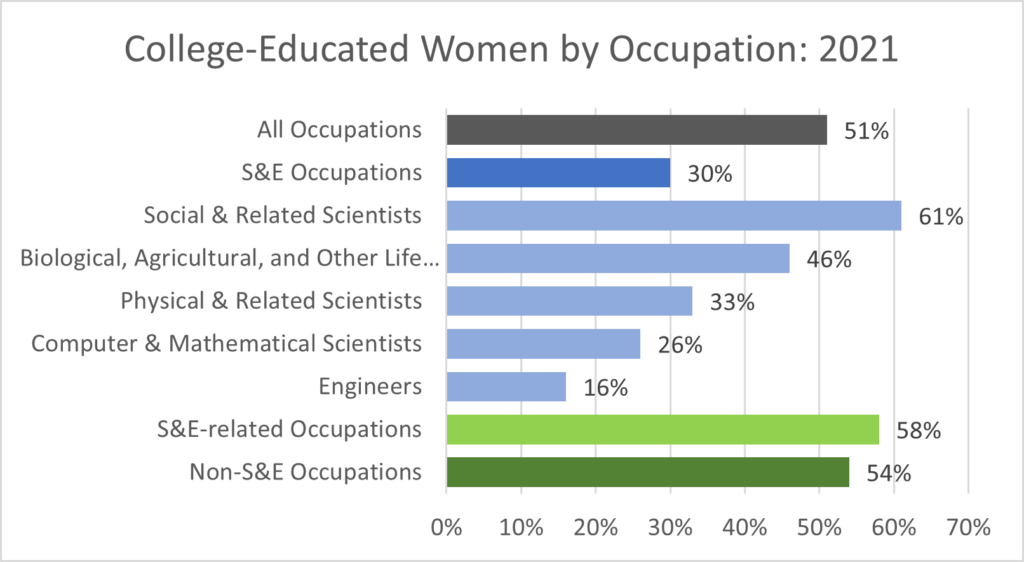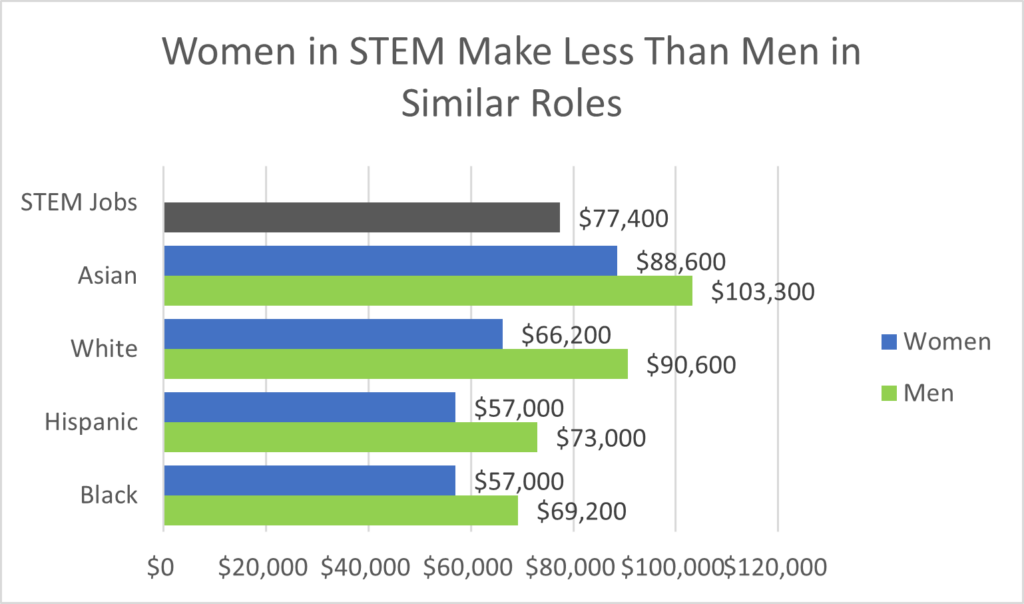The month of March celebrates National Women’s Month and International Women’s Day – a time where we can reflect on the accomplishments that could not have happened if it weren’t for women. This month also sheds light on the gaps that still exist today in working towards true gender equality. In comparison with other professional fields, STEM (Science, Technology, Engineering, and Math) often highlights the issue of a lack of female representation within the field. In this article, the Multicultural & Inclusive experts at Santiago Solutions group will deep dive into the obstacles women, especially women of color and minorities, face in a career in STEM.
EMPLOYMENT GAP
Although the movement towards gender equality has made many advancements over the last few decades, underrepresentation in the STEM workforce has been a recurrent and longstanding issue. According to the Diversity and STEM: Women, Minorities, and Persons with Disabilities 2023 Report from the National Science Foundation (NSF), even though female representation makes up 52% of the total US Workforce between the ages of 18 to 74, women comprised only 35% of the STEM workforce. As diversity, inclusion, and gender equality initiatives continue grow in importance in the US, women are entering STEM occupations at faster rate than men. However, this percentage has still only increased by 3% when comparing data from 2011 to 2021.[i]
Additionally, only 36% (including both men and women) of the STEM workforce is part of the multicultural community, and only 3% of STEM workers have one or more disabilities.
There is also an uneven distribution of women among the various STEM occupations. At the largest, women comprise 61% of Social and related scientists. At the smallest, women only make up 16% of Engineers. See the chart below for the full breakdown of college-educated women per S&E occupations[ii].

Source: Diversity and STEM: Women, Minorities, and Persons with Disabilities
Among the smaller percentage of women in these jobs, their struggles do not end once they get the job. 50% of women in the STEM workplace have reported that they have experienced at least one form of workplace and gender-related discrimination, such as receiving less support from senior leaders, being passed over on important assignments, being treated as less competent, denied a promotion, and of course – earning less than their male counterpart for doing the same job. [iii]
PAY GAP
Some people desire to work in STEM jobs due to the assumed stability and higher wages associated with the field. In fact, in a 2019 study by Pew Research Center, median earnings for a typical full-time STEM employee over the age of 25 was roughly $77,000 instead of the $47,000 salary for non-STEM employees. However, when looking at all racial groups – especially susceptible to wage inequalities at a median of $57,000, which is only 55% of what Asian men make at a median of $103,000.[iv]
Source: Pew Research Center
Women in the United States have continuously vocalized the gender pay gap for many years but have not made much progress in the past two decades. In 2022, women typically earned 82% of what men earned ($0.82 to $1.00). This has only increased by 2 cents from 2002, when women in the US earned 80 cents to the dollar when compared to men.[v] As seen as an example in the chart above, this pay gap percentage is even lower when looking at women of color.
In the STEM field and beyond, the continued gender pay gap not only affects the financial health of women, but mental health as well. A past study from Columbia University has shown that in the United States, working women are nearly twice as likely to have dealt with anxiety or depression in comparison to men and they believe that lower pay is a main contributor.[vi]
EDUCATION GAP
Unfortunately, this inequality in gender representation in the most well-known STEM occupations starts before people enter the workforce. According to the NSF study, the representation of women in STEM degree programs can vary heavily dependent on the specific field of study. For example,
- Women earned 66% of all bachelor’s degrees in social & behavioral sciences
- 79% of bachelor’s degrees in Psychology, but only 33% in Economics
- Women earned 64% of degrees in Agricultural & Biological Sciences
- Women earned 43% of bachelor’s degrees in Physical & Earth sciences
- 53% of chemistry degrees, but only 24% of Physics Degrees
- Women earned 26% of degrees in Mathematics & Computer Sciences
- Only 21% of Computer Science degrees
- Women earned only 24% of degrees in Engineering
Source: Diversity and STEM: Women, Minorities, and Persons with Disabilities
Universities across the United States not only have a desire, but a responsibility, to work towards closing the gender gap and other disparities by creating programs that appeal to college women and minorities. Better understanding the unique cultural nuances between men and women of different backgrounds is vital to the health and growth of university programs. The specific attitudes and values of women looking to join the STEM field can reveal great insights as to what the specific obstacles are that universities need to overcome in order to better reach their intended audiences. Santiago Solutions Group is the leading growth strategy consultancy across Gender, Generational, Hispanic, African American, Asian, LGBTQ+ and other inclusive segments. Our Solutions range from consumer insights discovery to opportunity sizing to strategy development to marketing operations and ROI optimization.
Sources:
[i] National Center for Science and Engineering Statistics (NCSES). 2023. Diversity and STEM: Women, Minorities, and Persons with Disabilities 2023. Special Report NSF 23-315. Alexandria, VA: National Science Foundation. Available at https://ncses.nsf.gov/wmpd
[ii] Definition of STEM Occupations as follows, taken from the NSF Report
“S&E occupations typically require a bachelor’s degree for entry and are broadly composed of workers who are computer and mathematical scientists; biological, agricultural, and environmental life scientists; physical scientists; social scientists; and engineers.
S&E-related occupations require STEM skills and expertise, but they do not fall into the five main S&E occupational categories listed above. The main occupational categories and positions that make up this group include health care workers, S&E managers, S&E precollege teachers, and technologists and technicians.
Middle-skill occupations require considerable STEM skills and expertise but do not typically require a bachelor’s degree for entry. These positions are primarily in the areas of construction trades, installation, maintenance, and production.”
[iii] Matulevich,Eliana Carolina; Beegle,Kathleen G.; Kumaraswamy,Sai Krishna. The Equality Equation : Advancing the Participation of Women and Girls in STEM : Main Report (English). Washington, D.C. : World Bank Group. http://documents.worldbank.org/curated/en/789951595308672516/Main-Report
[v] The Gender Wage Gap Endures in the U.S. | Pew Research Center
[vi] Jonathan Platt, Seth Prins, Lisa Bates, Katherine Keyes, Unequal depression for equal work? How the wage gap explains gendered disparities in mood disorders, Social Science & Medicine, Volume 149, 2016, https://doi.org/10.1016/j.socscimed.2015.11.056.

